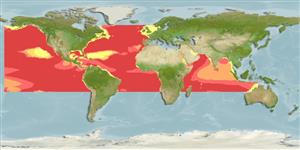Common names from other countries
>
Anguilliformes (Eels and morays) >
Serrivomeridae (Sawtooth eels)
Etymology: Serrivomer: Latin, serran, serranus, saw + Latin, vomer = ploughshare; in fishes = bone forming the front part of the roof of the mouth (1823) (Ref. 45335).
More on authors: Gill & Ryder.
Environment: milieu / climate zone / depth range / distribution range
Ökologie
seewasser bathypelagisch; tiefenbereich 0 - 6000 m (Ref. 117245). Deep-water; 82°N - 59°S, 179°W - 167°E
Atlantic Ocean: on both sides, between 60°N and 20°S (Ref. 5237); in the eastern Atlantic, reported to range further north to Iceland (Ref. 12462) and further south to off the Cape and Natal in South Africa (Ref. 5236). Indian Ocean: Reunion (Ref. 33390). Western Pacific: Australia (Ref. 7300).
Size / Gewicht / Alter
Maturity: Lm ? range ? - ? cm
Max length : 78.0 cm TL Männchen/unbestimmt; (Ref. 5236)
Kurzbeschreibung
Morphologie | Morphometrie
Head, abdomen and tail brown to black or silvery (Ref. 5236). Snout beak-like (Ref. 13608).
Epibenthic-pelagic (Ref. 58426). Solitary (Ref. 5951); exhibits vertical migrations during the night. Feeds on shrimps, other crustaceans and small fishes (Ref. 6722). Minimum depth from Ref. 58018.
Life cycle and mating behavior
Geschlechtsreife | Fortpflanzung | Ablaichen | Eier | Fecundity | Larven
Saldanha, L. and E. Karmovskaya, 1990. Serrivomeridae. p. 169-171. In J.C. Quero, J.C. Hureau, C. Karrer, A. Post and L. Saldanha (eds.) Check-list of the fishes of the eastern tropical Atlantic (CLOFETA). JNICT, Lisbon; SEI, Paris; and UNESCO, Paris. Vol. 1. (Ref. 5237)
IUCN Rote Liste Status (Ref. 130435)
CITES (Ref. 128078)
Not Evaluated
Bedrohung für Menschen
Harmless
Nutzung durch Menschen
Fischereien: nicht kommerziell
Mehr Information
NamenSynonymeMetabolismusRäuberÖkotoxikologieFortpflanzungGeschlechtsreifeAblaichenFecundityEierEientwicklung
Alter/GrößeWachstumLänge-GewichtLänge-LängeLängenhäufigkeitenMorphometrieMorphologieLarvenLarven Pop.Dyn.RekrutierungDichte
Tools
Zusatzinformationen
Download XML
Internet Quellen
Estimates based on models
Preferred temperature (Ref.
115969): 2.2 - 6.7, mean 3.8 (based on 2428 cells).
Phylogenetic diversity index (Ref.
82804): PD
50 = 0.5059 [Uniqueness, from 0.5 = low to 2.0 = high].
Bayesian length-weight: a=0.00102 (0.00046 - 0.00225), b=3.06 (2.88 - 3.24), in cm Total Length, based on all LWR estimates for this body shape (Ref.
93245).
Trophic level (Ref.
69278): 3.7 ±0.58 se; based on food items.
Widerstandsfähigkeit (Ref.
120179): niedrig, Verdopplung der Population dauert 4,5 - 14 Jahre. (Assuming tmax>10).
Fishing Vulnerability (Ref.
59153): Moderate to high vulnerability (51 of 100).
